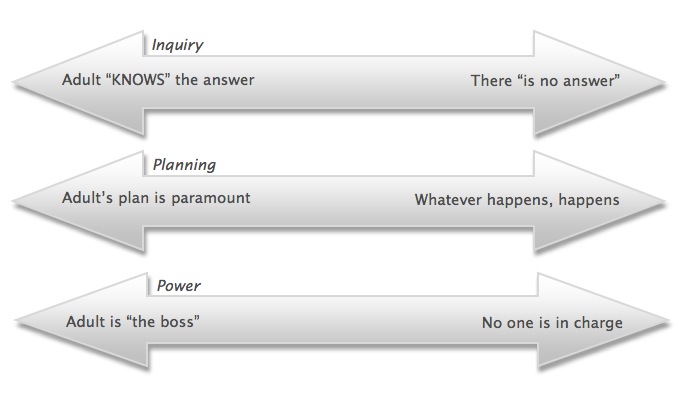There is no question that effective social emotional learning (SEL) has massive academic, social, and personal value (evidence). “Effective” is sometimes a challenge.
 Recently a student told me that she dreads the “SEL” class in her school because, “the teacher is so fake.” Predictably, she admits no willingness to honesty express herself in this forum. I’ve noticed that, especially with teens, their “radar” is up, and when adults posture (perhaps with the very best of intentions), credibility and trust evaporate.
Recently a student told me that she dreads the “SEL” class in her school because, “the teacher is so fake.” Predictably, she admits no willingness to honesty express herself in this forum. I’ve noticed that, especially with teens, their “radar” is up, and when adults posture (perhaps with the very best of intentions), credibility and trust evaporate.
At another extreme, many years ago we interviewed hundreds of young adults who had attended a school with the “Self-Science” process embedded, and over and over, they identified, without prompting, the value of SEL. In fact, just over 80% named Self-Science as the most valuable class they’d ever taken. What makes the difference?
In our EQ Educator training, we emphasize that the most basic ingredient for being an effective SEL facilitator is to be a practitioner yourself: To make emotional intelligence part of your own learning and life. This applies just as much to parents, counselors, and administrators as to teachers — and probably to all of us.
In considering some “SEL train wrecks” that I’ve observed and heard about, I notice three factors frequently emerge: Inquiry, Planning, and Power. Consider each on a continuum:
In “inquiry,” on the left, imagine an adult intervening in an issue between two kids. The adult enters the discussion thinking she already understands the situation. She might ask questions, she might even ask powerful questions, but the youth immediately “get it” that the the adult isn’t truly listening to the answers. At the opposite extreme, there are only questions, endlessly open-ended. Without meaningful observations and connecting the dots, the conversation never moves forward.
On the left end of “planning,” the adult is driven by his agenda. He has a “good lesson planned” and going through that process becomes more important than the reality of the situation. He doesn’t adapt (for example, noticing if the students are bored or tense or happy or sad). He follows his own agenda, and misses the opportunity to discuss real feelings and decisions because he’s so busy “teaching” the way he thinks the lesson should unfold. At the other extreme, it’s only process, and the opportunity for powerful learning is lost because of a lack of design.
With learners of all ages, “power” is a major driver, but perhaps with teens it’s the only currency. When the adult holds herself outside and above the group as “the boss,” they will see her as an obstacle rather than an ally. She can’t share honestly because that would give up the power of “being perfect.” She can’t flex because that might look like a loss of control. At the other extreme, we have Lord of the Flies; quiet voices are drowned out, and dialogue devolves quickly into posturing.
The challenge, of course, is to find balance in the middle ground. First and foremost, this requires us to accurately confront the current reality. When do I go to one extreme or another? What are my own habits, wants, and fears that can push me out of balance? If we’re unwilling to be fully honest — at least with ourselves — about our own “EQ messes,” it’s essentially impossible to teach others effectively.
In the middle of “Inquiry” is curiosity. Open, genuine, penetrating, flexible, playful and serious. Ask real questions, and learn from the answers. Even when the question isn’t answered, there are messages to hear. Call these out. Make observations (but not declarations). Ask around the corners and tease out insight.
To be balanced in planning, we need a structure for transformational learning, we need to over-plan and over-prepare to the point where we can drop the plan and let the learning unfold. Realplay is more powerful than roleplay, so watch for the moments of genuine emotion, struggle, hope, uncertainty, conflict, wonder… and weave that authentic experience back to reinforce the core concept that is valuable. Remember your goal is not to “complete a lesson,” nor is it to “just process,” but a perfect blend that awakens understanding.
Finally, we come to finding a balance of power. A lifelong challenge for all of us – it’s so easy to be provoked towards either dictatorship or victimhood. In the middle, we are building an alliance. We are open to the kids’ input, and when needed, we make the decision. We participate as part of the group, we reveal our true emotions and experience, and we maintain a clear boundary. When kids ask for more that we want to reveal, we don’t hide and pretend we’ve never grappled, we simply say, “It’s not something I’m comfortable talking about.” Some kids are amazingly adroit at pushing buttons, and trying to pull us into power struggle – great facilitators are like Tai Chi masters, simply stepping around to end up on the same side as allies.
I wish it were easy to follow these three principles. For myself, I know I’m more likely to slip off that gracefully balanced midpoint more often than not. Especially when I’m not at my very best, and I well remember how the relentless grinding pace of the school year makes that a dream for summertime.
And, it’s a process of learning. If, like me, you believe that teaching the skills of emotional intelligence is one of the most important gifts we can give children and the world, then we’re compelled to keep practicing. The good news / bad news is that these dynamics come up over and over, many times a day, giving us wonderfully difficult “gifts” of practice.

